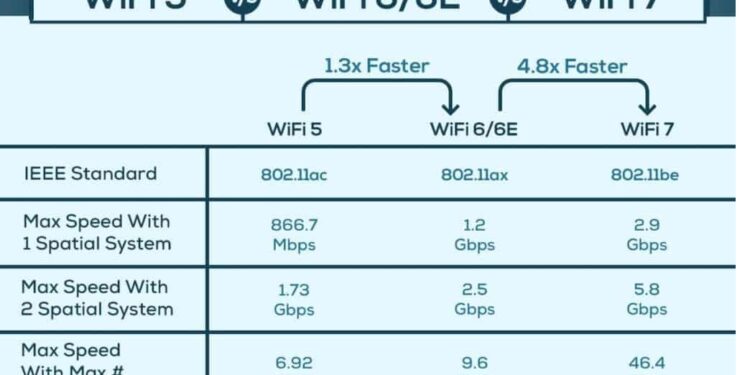In today’s digitally connected world, a reliable and fast internet connection is crucial for both work and leisure activities. With the introduction of WiFi 6, the latest generation of wireless technology, users are faced with the question of whether upgrading to this new standard is worth it, particularly if they have a 200 Mbps internet connection. Let’s delve deeper into the factors to consider before making a decision.
The Need for Speed:
One of the key selling points of WiFi 6 is its potential for lightning-fast speeds. Theoretically, WiFi 6 can deliver speeds of up to 9.6 Gbps, a significant leap from the 3.5 Gbps offered by WiFi 5. However, it’s important to recognize that these maximum speeds are seldom achievable in real-world scenarios due to various factors. For individuals with a 200 Mbps internet connection, the difference in speed between WiFi 5 and WiFi 6 might not be immediately noticeable. Engaging in typical online activities such as browsing, emailing, and even streaming high-definition video can be easily managed with a 200 Mbps connection.
Future-Proofing:
While your current 200 Mbps connection might not fully harness WiFi 6’s potential speed, considering the future is essential. Internet service providers often improve their offerings over time, and it’s conceivable that your internet connection might be upgraded beyond 200 Mbps in the future. In such a scenario, WiFi 6 would be better equipped to handle the increased bandwidth, ensuring that your wireless network doesn’t become a bottleneck.
Crowded Environments:
A standout feature of WiFi 6 is its enhanced performance in congested or densely populated areas. This is especially relevant if you have multiple devices connected to your network or live in an environment with numerous neighboring networks. WiFi 6’s Orthogonal Frequency Division Multiple Access (OFDMA) technology allows devices to share channels more efficiently, minimizing interference and maintaining stable connections. If you have a household full of smartphones, tablets, smart TVs, gaming consoles, and other IoT devices, WiFi 6 can prevent slowdowns caused by overcrowding.
Battery Efficiency:
Another advantage of WiFi 6 is its potential to extend the battery life of connected devices. Through the use of 1024-QAM modulation, WiFi 6 enables devices to transmit more data per packet, reducing the time they need to communicate with the router. This increased efficiency is especially beneficial for devices like laptops and smartphones, which rely heavily on battery power. In a scenario where you have numerous devices connected to WiFi 6, your gadgets could experience longer battery life due to improved communication efficiency.
Considerations and Conclusion:
In conclusion, the decision to upgrade to WiFi 6 with a 200 Mbps internet connection depends on a variety of factors. If you primarily use the internet for casual browsing, emailing, and light media consumption, the benefits of WiFi 6 might not be immediately essential. However, if your household is teeming with devices, you’re a heavy gamer, stream 4K content regularly, or your internet connection is expected to improve in the future, WiFi 6 can offer tangible advantages.
Moreover, it’s worth contemplating the cost of acquiring a WiFi 6 router, which can be higher than those supporting previous standards. Weighing the potential benefits against the financial investment is a critical aspect of the decision-making process.
Ultimately, consulting with a networking expert can provide personalized guidance based on your specific circumstances. They can help you determine whether the advantages of WiFi 6 align with your current and future internet usage patterns, ensuring that you make an informed decision regarding this technological upgrade.
IS WiFi 7 Coming?
Yes, WiFi 7 is coming. It is the next generation of Wi-Fi technology, and it is expected to offer significant improvements over WiFi 6.
WiFi 7 is expected to have theoretical speeds of up to 46 Gbps, which is much faster than the 9.6 Gbps of WiFi 6. It will also be more efficient, so it can handle more devices in a crowded area without experiencing performance problems.
WiFi 7 is still under development, but it is expected to be released in the early 2025. However, it may be a few years before WiFi 7 devices become widely available.
If you are considering upgrading your Wi-Fi network, it is probably not worth waiting for WiFi 7. WiFi 6 is still a very capable technology, and it will be able to meet the needs of most users for the foreseeable future.
Here are some of the key features of WiFi 7:
- 320 MHz ultra-wide bandwidth: This will allow WiFi 7 to achieve much faster speeds than previous Wi-Fi standards.
- 4096-QAM: This modulation technique will allow WiFi 7 to transmit more data per packet, which will also improve speeds.
- Multi-RU: This feature will allow WiFi 7 to use multiple radio units simultaneously, which will further improve speeds.
- Multi-Link Operation: This feature will allow WiFi 7 devices to connect to multiple access points at the same time, which will improve performance in crowded areas.
Overall, WiFi 7 is a significant upgrade over WiFi 6. It offers faster speeds, better efficiency, and more features. If you are looking for the best possible Wi-Fi experience, then WiFi 7 is the way to go.





